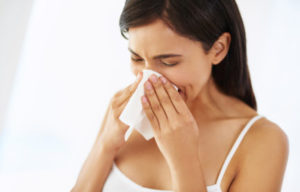- Pollen is spread by the wind and highest on dry, windy days
- Pollen is also highest in the morning hours (and late afternoon). Limit outdoor activity at dawn and dusk.
- Stay indoors as much as possible when pollen counts are at their peak.
- Keep windows closed at home and in the car. Use an air conditioner to filter the air. Clean or replace air-conditioning filters on a monthly basis with in use. Avoid using window fans that can draw pollens and molds into the house.
- Do not hang clothes outside to dry.
- Wear a pollen mask (such as a NIOSH-rated 95 filter mask) when mowing the lawn, raking leaves or gardening, and take appropriate medication beforehand.
- Wear glasses or sunglasses when outdoors to minimize the amount of pollen getting into your eyes.
- After completing activities, change your clothes to remove pollen. A shower or bath is even better.

Looking out the window and seeing snow fall, allergies may be out of sight and out of mind. However, in the Northeastern United States trees will start to bloom in about two months. For those of us allergic to tree pollen this can be a difficult time. Runny nose, sneezing and itchy eyes are more than a nuisance. Before you suffer, miss work or school, make a plan to beat spring allergies.
Step 1. Find out what you are allergic to. Different plants pollinate at different times. For example, birch trees pollinate early in the spring, as soon as mid-March. Grass pollens tend to peak later on, in the early summer.
Step 2. Track pollen counts and do your best to avoid pollen. Here are some tips: